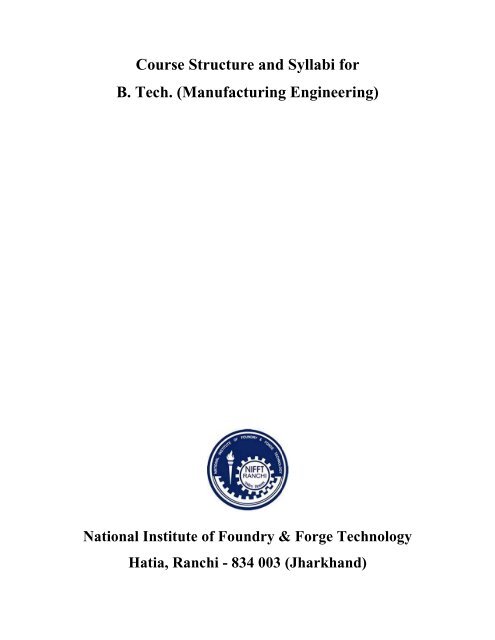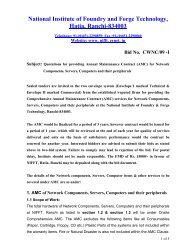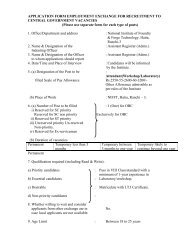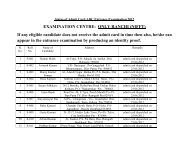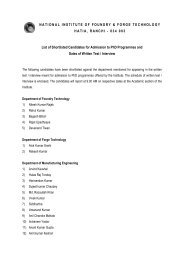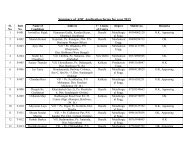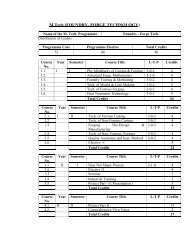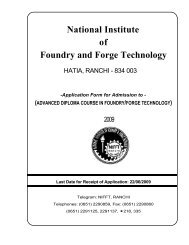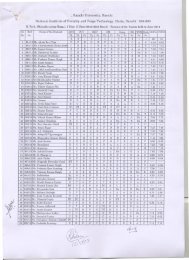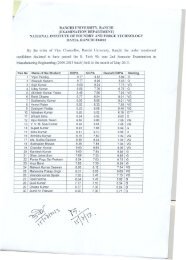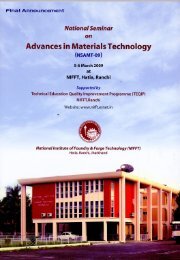Course Structure and Syllabus - National Institute of Foundry ...
Course Structure and Syllabus - National Institute of Foundry ...
Course Structure and Syllabus - National Institute of Foundry ...
You also want an ePaper? Increase the reach of your titles
YUMPU automatically turns print PDFs into web optimized ePapers that Google loves.
<strong>Course</strong> <strong>Structure</strong> <strong>and</strong><br />
Syllabi for<br />
B. Tech. (Manufacturing<br />
Engineering)<br />
<strong>National</strong> <strong>Institute</strong><br />
<strong>of</strong> <strong>Foundry</strong> & Forge Technology<br />
Hatia, Ranchi - 834 003 (Jharkh<strong>and</strong>)
B. TECH. (MANUFACTURING ENGINEERING) - COURSE STRUCTURE<br />
Year<br />
I<br />
I<br />
II<br />
II<br />
Sem.<br />
I<br />
II<br />
I<br />
II<br />
<strong>Course</strong><br />
No.<br />
Subject L-T-P Credits Total<br />
Mathematics I 3-1-0 4<br />
Principles <strong>of</strong> Electrical Engineering 3-0-2 4<br />
Chemistry 3-0-2 4<br />
Engineering Mechanics 3-1-0 4<br />
English for Pr<strong>of</strong>essional<br />
Communication<br />
3-0-2 4<br />
Engineering Graphics I 1-0-2*2 3<br />
Workshop Practice I 0-0-2 1<br />
EAA (NCC/NSS/PT) 0-0-2 1<br />
Mathematics II 3-1-0 4<br />
Basic Electronics 3-0-2 4<br />
Solid Mechanics 3-1-2 5<br />
Physics <strong>of</strong> Materials 3-0-2 4<br />
Introduction to Computers <strong>and</strong><br />
Programming Languages<br />
3-0-2 4<br />
Engineering Graphics II 1-0-2*2 3<br />
Workshop Practice II 0-0-2 1<br />
EAA (NCC/NSS/PT) 0-0-2 1<br />
Mathematics III 3-1-0 4<br />
Fluid Mechanics 3-1-2 5<br />
Materials Science <strong>and</strong> Engineering 3-0-2 4<br />
Industrial Economics 3-0-0 3<br />
Engineering Thermodynamics 3-1-0 4<br />
Environmental Pollution <strong>and</strong> Control 3-0-2 4<br />
Elective I 3-0-0 3<br />
EAA (NCC/NSS/PT) 0-0-2 1<br />
Heat <strong>and</strong> Mass Transfer 3-1-0 4<br />
Metal Casting <strong>and</strong> Welding<br />
Technology<br />
4-0-2 5<br />
Kinematics <strong>and</strong> Dynamics <strong>of</strong><br />
Machines<br />
3-1-0 4<br />
Scientific Computation 3-0-2 4<br />
Metal Forming Technology 3-0-2 4<br />
Control Theory <strong>and</strong> Applications 3-1-0 4<br />
EAA(NCC/NSS/PT) 0-0-2 1<br />
25<br />
26<br />
28<br />
26
Year<br />
III<br />
III<br />
IV<br />
IV<br />
Sem.<br />
I<br />
II<br />
I<br />
II<br />
<strong>Course</strong><br />
No.<br />
Subject L-T-P Credits Total<br />
Operational Research I 3-1-0 4<br />
Design <strong>of</strong> Machine Elements 3-0-2 4<br />
Principles <strong>of</strong> Metal Cutting 3-0-2 4<br />
Machine Tools 3-0-2 4<br />
Engineering Metrology 3-0-2 4<br />
Computer Graphics 3-0-2 4<br />
Advanced Manufacturing Processes 3-0-2 4<br />
Finite Element Methods <strong>and</strong><br />
Applications<br />
3-0-2 4<br />
Advanced Metal Forming 3-0-2 4<br />
Industrial Engineering 3-1-0 4<br />
Manufacturing Systems Engineering 3-1-0 4<br />
Technology <strong>of</strong> Special <strong>Foundry</strong><br />
Processes<br />
3-0-2 4<br />
Quality Assurance <strong>and</strong> Reliability 3-0-0 3<br />
Forging Die Design <strong>and</strong> Manufacture 3-0-2 4<br />
Machine Tools Design 3-0-2 4<br />
Materials Management 3-0-0 3<br />
Elective II<br />
3-1-0/<br />
3-0-2<br />
4<br />
Elective III<br />
3-1-0/<br />
3-0-2<br />
4<br />
Industrial Training ----- NC<br />
Colloquium 0-3-0 3<br />
Elective IV<br />
3-0-2/<br />
3-1-0<br />
4<br />
Elective V<br />
3-1-0/<br />
3-0-2<br />
4<br />
Elective VI<br />
3-1-0/<br />
3-0-2<br />
4<br />
Major Project ------ 10<br />
24<br />
24<br />
25<br />
22<br />
TOTAL CREDITS (8 SEMESTERS) = 200<br />
ELECTIVES<br />
Elective I<br />
Introduction to Sociology<br />
Industrial Psychology<br />
Management Concepts <strong>and</strong> Techniques - An Introduction<br />
French Language<br />
German Language
Elective II<br />
Material H<strong>and</strong>ling Systems <strong>and</strong> Equipment<br />
Automobile Engineering<br />
Geometric Modeling for Manufacturing<br />
Advanced Numerical Modeling<br />
Advanced Welding Technology<br />
Elective III<br />
Manufacture <strong>of</strong> Plastics <strong>and</strong> Ceramic Products<br />
Facility Layout <strong>and</strong> Design<br />
Rapid Prototyping <strong>and</strong> Reverse Engineering<br />
Operational Research II<br />
Heat Treatment Technology<br />
Elective IV<br />
Project Management<br />
Knowledge Management for Competitiveness<br />
Supply Chain Management<br />
Industrial Tribology<br />
Methoding <strong>of</strong> Castings<br />
Elective V<br />
Total Quality Management<br />
Design for Manufacturing <strong>and</strong> Assembly<br />
Micro <strong>and</strong> Nano Manufacturing<br />
Concurrent Engineering<br />
Design <strong>and</strong> Manufacturing <strong>of</strong> Composites<br />
Elective VI<br />
Fluid Power Control<br />
Mechatronics<br />
Non-Destructive Testing<br />
Evolutionary Computing<br />
Laser Applications in Manufacturing
DETAILED SYLLABUS<br />
Mathematics I<br />
(3-1-0) 4 Credits<br />
Matrices: Definitions, Addition <strong>and</strong> multiplication, Square matrices <strong>of</strong> different types,<br />
Determinants, Adjoint <strong>and</strong> inverse <strong>of</strong> a matrix, Elementary transformation, Rank, Normal<br />
form, Solution <strong>of</strong> line equations, Solvability, Matrix algebra, Cayley-Hamilton theorem,<br />
Eigen values <strong>and</strong> Eigen functions.<br />
Coordinate geometry <strong>of</strong> two dimensions: Coordinate systems, Projections <strong>and</strong> directions,<br />
Plane, Straight line, Sphere, Cylinder, Cone <strong>and</strong> conicoids.<br />
Vector analysis (with geometrical interpretation <strong>and</strong> applications): Elementary<br />
discussion, Product <strong>of</strong> two or more vectors, Geometry <strong>of</strong> line, plane <strong>and</strong> sphere in terms <strong>of</strong><br />
vectors.<br />
Differential calculus: Continuity <strong>and</strong> differentiability, Differentiation, Successive<br />
differentiation, Successive differentiation, Expansion <strong>of</strong> function remainders, Indeterminate<br />
forms, Partial differentiation, Total differential coefficients, To differential, Approximate<br />
calculations, Jacobians, Reduction <strong>of</strong> Laplacian operator in different coordinate systems.<br />
Differential equation: Introduction.<br />
Principles <strong>of</strong> Electrical Engineering<br />
(3-0-2) 4 Credits<br />
DC Circuits: Circuit Elements & their characteristics, Circuit Analysis using KCL, KVL,<br />
solution <strong>of</strong> Mesh & Nodal equations <strong>of</strong> R-L-C networks, Circuits theorems – Superposition,<br />
Thevinin, Norton, Max. Power transfer & Reciprocity Theorem.<br />
AC Circuits analysis: Periodic wave form, Peak, Average, RMS, Form factor <strong>of</strong> AC<br />
quantity, RLC circuits with sinusoidal excitation, Phaser notation, Reactance & Impedance,<br />
Series <strong>and</strong> Parallel Resonance.<br />
Polyphase Circuits: Three phase system, star – Delta connected sources <strong>and</strong> loads. 3- Wire<br />
& 4 – wire system, Phaser diagram, Balanced <strong>and</strong> Unbalanced systems line & phase values,<br />
Power measurement.<br />
Magnetic Circuits: Definition <strong>of</strong> magnetic quantities, concepts <strong>of</strong> magnetic <strong>and</strong> electrical<br />
analogy, B-H curve, cyclic magnetization, Leakage, Hysteresis & Fringing, Core losses.<br />
Electromagnetic induction: Faraday’s law, dynamic Induction, Fleming’s RHR & LHR,<br />
Self <strong>and</strong> Mutual Induction, Lenz’s Law, Coupling coefficient.<br />
Chemistry<br />
(3-0-2) 4 credits<br />
Chemistry <strong>of</strong> engineering materials with particular reference to metals, alloys, ceramics <strong>and</strong><br />
glasses, introduction to Water treatment techniques.<br />
Electrochemistry-Electrochemical reactions, Electrochemical cells, laws <strong>of</strong> electrolysis,<br />
conductance, electroplating, electroanalytical methods <strong>of</strong> chemical analysis such as<br />
conductometry, potentiometry <strong>and</strong> polarography.<br />
Thermochemistry- Heat <strong>of</strong> combustion, heat <strong>of</strong> formation, Hess’s law <strong>of</strong> heat <strong>of</strong> summation,<br />
heat <strong>of</strong> neutralization, calorimetry.
Polymers-Classification <strong>of</strong> polymers, properties <strong>of</strong> polymers, methods <strong>of</strong> polymerization,<br />
common polymer resins such as phenolic resin, amine resin, alkyd resin, polyesters, epoxy<br />
resin, polyurethane <strong>and</strong> furan polymers.<br />
Spectroscopy - Emission <strong>and</strong> absorption spectroscopy, origin <strong>of</strong> spectra, principles, methods<br />
<strong>of</strong> chemical analysis based on spectroscopy, such as atomic <strong>and</strong> molecular absorption.<br />
Engineering Mechanics<br />
(3-1-0) 4 Credits<br />
Introduction: Fundamental concepts <strong>and</strong> principles; Introduction to SI units; Review <strong>of</strong><br />
vector Algebra; Important vector quantities;<br />
Statics <strong>of</strong> particles: Concept <strong>of</strong> force; resultant <strong>of</strong> forces; resolution <strong>of</strong> forces; Equilibrium<br />
<strong>of</strong> particle.<br />
Statics <strong>of</strong> rigid bodies: Definition <strong>of</strong> rigid body; Dot product <strong>and</strong> cross product <strong>of</strong> two<br />
vectors; mixed triple product <strong>of</strong> three products; Moment <strong>and</strong> couple; Varignon’s theorem;<br />
Equivalent system <strong>of</strong> forces; simplest resultants; Equilibrium <strong>of</strong> rigid bodies.<br />
Analysis <strong>of</strong> structures: determination <strong>of</strong> forces in members <strong>of</strong> plane trusses by method <strong>of</strong><br />
joints <strong>and</strong> sections.<br />
Friction: the laws <strong>of</strong> dry friction; wedges; square threaded power screws; belt friction.<br />
Properties <strong>of</strong> surface: Centroids <strong>and</strong> centers <strong>of</strong> gravity <strong>of</strong> areas <strong>and</strong> lines, volumes;<br />
Theorems <strong>of</strong> Pappus-Guldinus; Second moment <strong>of</strong> inertia, <strong>of</strong> an area; Polar moment <strong>of</strong><br />
inertia; Parallel axis theorem.<br />
Kinematics <strong>of</strong> particles: Position, velocity <strong>and</strong> acceleration <strong>of</strong> a particle in rectilinear <strong>and</strong><br />
curvilinear motion; Relative motion; Motion <strong>of</strong> projectiles; Tangential <strong>and</strong> normal<br />
components <strong>of</strong> acceleration.<br />
Kinetics <strong>of</strong> particles: Newton’s second law <strong>of</strong> motion; Equation <strong>of</strong> motion; Dynamic<br />
equilibrium.<br />
Kinematics <strong>of</strong> rigid bodies: Introduction; Translation; Rotation about a fixed axis; General<br />
plane motion; Absolute <strong>and</strong> relative velocity in plane motion; Plane motion <strong>of</strong> a particle<br />
relative to a rotating frame - Corriolis acceleration; Motion about a fixed point; General<br />
motion.<br />
English for Pr<strong>of</strong>essional Communication<br />
(3-0-2) 4 Credits<br />
Communication: Its role, process, barriers, dealing with barriers, Psychology insights into<br />
communication, Role <strong>of</strong> personality- personality types, transactional analysis.<br />
Verbal Skills: Sound pattern, phonetics, pronunciation, modulation, stress, elision, vocal<br />
qualifiers, rhythm, vocal segregates, characteristics <strong>and</strong> sound patterns.<br />
Non verbal Skills: Paralanguage, gestures, prescenics, Kinesics<br />
Listening Skills: Types <strong>and</strong> techniques <strong>of</strong> developing it.<br />
Presentation Skills: Making presentation, audio-video use (visual aids), the role <strong>of</strong> PLAN in<br />
presentation, characteristic <strong>of</strong> good speech <strong>and</strong> presentation<br />
Written Skills: Fundamentals <strong>of</strong> English Grammars, usage, Editing, Effective writing,<br />
drafting, proposals, report, <strong>of</strong>ficial letter writing, use <strong>of</strong> positive <strong>and</strong> negative language,<br />
persuasive letters, orders, messages, Style-concise, precision <strong>and</strong> vocabulary<br />
Use <strong>of</strong> language for specific goal/audience/reader
Engineering Graphics I<br />
(1-0-2*2) 3 Credits<br />
Introduction: Importance <strong>of</strong> Engineering Drawing, Drawing instruments <strong>and</strong> uses, BIS<br />
specifications, Layout <strong>of</strong> drawing sheets. Lines, lettering <strong>and</strong> dimensioning.<br />
Conic Sections: Ellipse, Parabola <strong>and</strong> Hyperbola<br />
Curves: Cycloid, Epicycloid, Involutes, Spirals <strong>and</strong> Helices<br />
Projections: Theory <strong>of</strong> projections. Orthographic projections. Projection <strong>of</strong> points <strong>and</strong><br />
straight lines.<br />
Projections <strong>of</strong> Solids: Projections <strong>of</strong> solids with the axis parallel, perpendicular <strong>and</strong> inclined<br />
to reference planes. Auxiliary projections.<br />
Intersection <strong>of</strong> Surfaces: Intersection between prism, cylinder <strong>and</strong> cone combinations with<br />
axes in the same plane.<br />
Development <strong>of</strong> Surfaces: parallel line, Radial line, Triangulation <strong>and</strong> Approximate<br />
development methods <strong>of</strong> surfaces <strong>of</strong> solids.<br />
Pictorial Projections: Isomeric projections <strong>and</strong> Isomeric Views <strong>of</strong> Solids <strong>and</strong> Combination<br />
<strong>of</strong> solids, Perspective Projections <strong>of</strong> Solids <strong>and</strong> Combination <strong>of</strong> Solids using Visual Ray<br />
method <strong>and</strong> Vanishing Point method.<br />
Sections <strong>of</strong> Solids: Section planes. Projections <strong>of</strong> solids with section planes parallel,<br />
perpendicular <strong>and</strong> inclined to reference planes. True shape <strong>of</strong> sections.<br />
Computer Aided Drafting: Introduction to computer Aided Drafting.<br />
Workshop Practice I<br />
(0-0-2) 1 Credit<br />
Machining <strong>of</strong> wood <strong>and</strong> plastic materials, fitting, smithy, tools <strong>and</strong> processes. Selected<br />
exercise in carpentry, fitting <strong>and</strong> h<strong>and</strong> forging. Use <strong>of</strong> measuring tools, instruments <strong>and</strong><br />
gauges.<br />
Mathematics II<br />
(3-1-0) 4 Credits<br />
Vector Calculus: Differentiation <strong>of</strong> vectors <strong>and</strong> their products, Differential operators,<br />
Gradient, Divergence, Curl in relation to scalars <strong>and</strong> vectors <strong>and</strong> their functions, Physical<br />
interpretations : Line <strong>and</strong> Surface integrals, Gauss <strong>and</strong> Stokes theorems.<br />
Complex Analysis: Introduction, analytic functions, Cauchy-Riemann equations, Line<br />
integral, Cauchy integral theorem <strong>and</strong> formula; Taylor <strong>and</strong> Laurent series, Cauchy’s residue<br />
theorem, Single point, Point at infinity, Liouville theorem, Jordan’s lemma, Evaluation <strong>of</strong><br />
definite integrals, Bromwich contour integral, Branch points <strong>and</strong> contour integrals.<br />
Algebra: Series - Tests <strong>of</strong> convergence <strong>and</strong> divergence <strong>of</strong> series, Pro<strong>of</strong>s <strong>of</strong> tests,<br />
Convergence <strong>of</strong> infinite products.<br />
Integral Calculus: Methods <strong>of</strong> integration, Integration <strong>of</strong> irrational algebraic <strong>and</strong><br />
trigonometric functions , Reduction formulae, Definite integrals, Geometrical properties,<br />
Quadrature, Rectification, Volumes <strong>and</strong> surfaces, Differentiation <strong>and</strong> integration <strong>of</strong> integrals,<br />
Gamma <strong>and</strong> Beta functions, Multiple integrals with change <strong>of</strong> variable, Application to centre<br />
<strong>of</strong> gravity <strong>and</strong> moment <strong>of</strong> inertia.
Basic Electronics<br />
(3-0-2) 4 credits<br />
Semiconductor Diode Characteristics: Qualitative theory <strong>of</strong> pn-junction, pn-junction as a<br />
diode, Current components in a pn-diode, the volt-Amp. Characteristics/diode resistance,<br />
Breakdown diodes, Photo diodes, LEDs.<br />
Transistor Characteristics: The junction transistor, transistor current components,<br />
transistor as an amplifier, Transistor construction, detailed study <strong>of</strong> the current in a transistor,<br />
the transistor-Alpha, the common-Base configuration, the common- Emitter configuration,<br />
the common- Collector configuration, transistor biasing technique <strong>and</strong> thermal stabilization.<br />
Field-Effect Transistor: Junction field-effect transistor, pinch-<strong>of</strong>f voltage, JFET volt-Amp.<br />
Characteristics, the insulated gate FET (MOSFET), a generalized FET amplifier, biasing <strong>of</strong><br />
FET, the FET as a voltage-variable resistor (VVR)<br />
Rectifier: Half wave rectifier, Ripple factor, Full wave rectifier, Full wave circuits, the<br />
Bridge rectifier voltage-multiplier, Filters (L-filter, C-filter, L-C filter)<br />
Untuned Amplifiers: Classification <strong>of</strong> amplifiers, push-pull amplifiers, class-A large signal<br />
amplifier, class-B & class-AB <strong>and</strong> their operation, RC coupled amplifier, low frequency<br />
response <strong>of</strong> an RC-coupled stage.<br />
Feedback Amplifier <strong>and</strong> Oscillators: Feedback concept, general characteristic <strong>of</strong> negative<br />
feedback amplifiers, voltage series feedback, current shunt feedback, voltage shunt feedback,<br />
operational-amplifier, basic uses <strong>of</strong> op-Amp., Sinusoidal oscillators, the Phase shift<br />
oscillators, Resonant-circuit oscillators, Crystal oscillators.<br />
Digital Electronics: Number system, Boolean algebra, Universal logic gates, Realization,<br />
Karnaugh’s map, Flip-Flop, Registers <strong>and</strong> Counters.<br />
Solid Mechanics<br />
(3-1-2) 5 Credits<br />
Introduction: Types <strong>of</strong> loads; Concepts <strong>of</strong> stress <strong>and</strong> strain; Normal <strong>and</strong> Shearing stress;<br />
Stress-strain Diagram; Hooke’s law; Deformation <strong>of</strong> Axially loaded Members; Statically<br />
Indeterminate problems; Thermal stresses <strong>and</strong> strains; Deformation <strong>of</strong> compound bars;<br />
Lateral strain ;Poisson’s ratio; Generalized Hooke’s law; Bulk Modulus; Shearing strain;<br />
Elastic constants <strong>and</strong> their relationships.<br />
Torsion: Theory <strong>of</strong> torsion; Deformation in a circular shaft; Statically Indeterminate<br />
Problems; Power transmission Shafts.<br />
Pure bending: Theory <strong>of</strong> simple Bending; Deformation in a Symmetric Member in pure<br />
Bending; Normal Stresses due to bending <strong>of</strong> beams; Bending <strong>of</strong> composite beams.<br />
Transverse loading: Horizontal Shear flow; Shearing Stresses in beams; Shear stress,<br />
Distribution in common types <strong>of</strong> Beams.<br />
Shear force <strong>and</strong> Bending Moment: Relation among loads, Shearing force <strong>and</strong> Bending<br />
Moment; Shearing force <strong>and</strong> Bending Moment diagrams for cantilever, Simply-Supported<br />
<strong>and</strong> Overhanging Beams; Maximum Bending Moment <strong>and</strong> pouts <strong>of</strong> contra-flexure.<br />
Transformation <strong>of</strong> Stress: Principal Stress <strong>and</strong> their Planes; Mohr’s Circle for Plane Stress;<br />
Combined loading.<br />
Thin walled Pressure vessels: Hoop <strong>and</strong> Longitudinal Stresses in Thin Cylindrical <strong>and</strong><br />
spherical shells subjected to internal pressure; Changes in Dimensions <strong>and</strong> volumes.
Columns: Bucking <strong>of</strong> Columns due to axial loads; Euler’s formula for Column with<br />
different end conditions.<br />
Physics <strong>of</strong> Materials<br />
(3-0-2) 4 Credits<br />
Nature <strong>of</strong> waves <strong>and</strong> particles, Wave-packets <strong>and</strong> uncertainty, Wave particle duality, Wave<br />
mechanics <strong>and</strong> its mathematical tools, Classical <strong>and</strong> quantum statistics, Statistics <strong>of</strong> discrete<br />
energy levels, Black body spectral density, Bose condensation; Free electrons, density <strong>of</strong><br />
states, Kronig-Penny model, Effective mass, B<strong>and</strong> structure, Electrons in various types <strong>of</strong><br />
solids, Particle in quantum well, Harmonic oscillator, Application to semiconductor doping,<br />
Non-periodic materials; Tunneling <strong>of</strong> particles <strong>and</strong> examples, Tunneling through multiple<br />
barriers <strong>and</strong> semiconductor junctions; Interaction among quantum wells: materials under<br />
electric <strong>and</strong> magnetic fields, magnetic resonance effects; Nanostructures – Concepts <strong>of</strong><br />
electrons in low dimensional confinement, Quantum wells <strong>and</strong> Super-lattices leading to new<br />
device concepts; Lasers - Einstein coefficients, Population inversion, Light amplification,<br />
Optical resonators, Characteristics <strong>of</strong> lasers; Superconductors<br />
Introduction to Computers <strong>and</strong> Programming Languages<br />
(3-0-2) 4 Credits<br />
Introduction to computer systems; Representation <strong>of</strong> data in computers; Number systems.<br />
FORTRAN language: FORTRAN preliminaries, input <strong>and</strong> output statements, format<br />
specifications, control statements, arrays, subprograms, file processing.<br />
C++ language: Introduction, constants, variables <strong>and</strong> data types. Operators <strong>and</strong> expressions,<br />
Input/output streams, decision making <strong>and</strong> branching, looping, functions, arrays <strong>and</strong> pointers,<br />
Objects <strong>and</strong> classes.<br />
Engineering Graphics II<br />
(1-0-2*2) 3 Credits<br />
Introduction to design process <strong>and</strong> drawings.<br />
Conventions: Code <strong>of</strong> practice for engineering drawing - Methods <strong>of</strong> dimensioning -<br />
Representation <strong>of</strong> details like drilled <strong>and</strong> tapped holes, counter-sunk <strong>and</strong> counter-bored holes,<br />
etc. - Representation <strong>of</strong> st<strong>and</strong>ard components like bolts, nuts, washers, etc.<br />
Assembly concepts: Methods <strong>and</strong> concepts <strong>of</strong> assemblies - Assembly requirements -<br />
Methods <strong>of</strong> assembly using bolts, nuts, screws <strong>and</strong> pins - Methods <strong>of</strong> arresting motion <strong>of</strong> a<br />
member in an assembly.<br />
Assembly drawing practice: Making free h<strong>and</strong> sketches <strong>of</strong> typical sub-assemblies, like<br />
flange couplings, stuffing box, journal bearings, rolling element bearings, keyed joints, cotter<br />
joints, gears, belts, brackets <strong>and</strong> C-clamps. Detailed three view drawings <strong>of</strong> assemblies <strong>of</strong> (i)<br />
stop valve (ii) tail stock (iii) hydraulic cylinder <strong>and</strong> piston (iv) four speed gear box (v)<br />
universal joint (vi) cross head (vii) connecting rod (viii) safely valve (ix) machine vice <strong>and</strong><br />
(x) screw jack. Assembly drawing with sectioning <strong>and</strong> bill <strong>of</strong> materials; Assembly <strong>and</strong><br />
disassembly; Detailed part drawings from assembly drawings.<br />
Production drawings - Limits, fits <strong>and</strong> tolerances, dimensional <strong>and</strong> geometric tolerances,<br />
surface finish symbols. Computer aided design <strong>and</strong> use <strong>of</strong> s<strong>of</strong>tware packages for engineering<br />
drawings.
Workshop Practice II<br />
(0-0-2) 1Credit<br />
Metal casting, welding, sheet metal fabrication <strong>and</strong> basic machining processes; Materials,<br />
tools <strong>and</strong> instruments used; Elementary exercises in molding, casting, gas <strong>and</strong> arc welding,<br />
sheet metal forming, turning, shaping <strong>and</strong> milling.<br />
Mathematics III<br />
(3-1-0) 4 Credits<br />
Differential Equations: Definitions, Differential Equations <strong>of</strong> First Order: <strong>of</strong> First Degree<br />
<strong>and</strong> higher, Singular Solutions, Geometrical Interpretation <strong>of</strong> Differential Equations, Linear<br />
Equations <strong>of</strong> Higher Order with: Constant Coefficients <strong>and</strong> Variable Coefficients (Second<br />
Order <strong>and</strong> Homogeneous equations), Simultaneous Differential Equations <strong>of</strong> One or More<br />
Variable, Partial Differential Equations, Total Differential Equations, Geometrical<br />
Interpretations, Solution <strong>of</strong> Laplace Equation, Heat Conduction Equation <strong>and</strong> Wave<br />
Equations by Separation <strong>of</strong> Variables in Cartesian, Cylindrical & Spherical Polar Coordinate<br />
Systems.<br />
Special Functions: Solution <strong>of</strong> Legendre <strong>and</strong> Bessel Differential Equations, Different Kinds<br />
<strong>of</strong> Associated Functions, Generating Functions, Orthogonality Conditions, Expansion <strong>of</strong><br />
Functions in terms <strong>of</strong> Legendre Polynomials <strong>and</strong> Bessel Functions.<br />
Integral Transforms: Definitions, Laplace Transforms, Inverse Laplace Transforms,<br />
Fourier Series- Expansion, Conversion into Different Intervals. Fourier Integral Formula,<br />
Fourier Mellin Theorem, Infinite <strong>and</strong> Finite Fourier Transforms & Hankel Transforms,<br />
Definite Integrals with the Help <strong>of</strong> Transforms, Application <strong>of</strong> Transforms to the Solution <strong>of</strong><br />
Boundary Value Problems, Heat <strong>and</strong> Wave Equations.<br />
Fluid Mechanics<br />
(3-1-2) 5 Credits<br />
Introduction. Definitions. Fluid properties: classification <strong>of</strong> fluids <strong>and</strong> flow regimes. Fluid<br />
statics: Stationary fluids <strong>and</strong> liquids subjected to constant linear acceleration <strong>and</strong> to constant<br />
rotation. Fluid kinematics: Lagrangian <strong>and</strong> Eulerian descriptions, pathlines, streaklines <strong>and</strong><br />
streamlines, acceleration. Integral flow analysis: Reynolds transport theorem, conservation <strong>of</strong><br />
mass/continuity equation <strong>and</strong> conservation <strong>of</strong> linear <strong>and</strong> angular momentum for a control<br />
volume in inertial <strong>and</strong> accelerating reference frames, energy equation, Bernoulli’s equation,<br />
engineering applications. Differential analysis <strong>of</strong> flow: Continuity <strong>and</strong> Navier-Stokes<br />
equations. Dimensional analysis <strong>and</strong> Similitude theory. Inviscid flows: Irrotational flow,<br />
circulation, velocity potential <strong>and</strong> applications. Viscous flows in pipes <strong>and</strong> ducts. External<br />
viscous flows: concepts <strong>of</strong> boundary layer, momentum integral equation, drag <strong>and</strong> lift,<br />
separation.<br />
Materials Science <strong>and</strong> Engineering<br />
(3-0-2) 4 Credits<br />
<strong>Structure</strong>s <strong>of</strong> materials – crystal structure, substructure, microstructure, etc. Phase diagram<br />
<strong>and</strong> phase transformation. Diffusion phenomenon. Principles <strong>of</strong> heat treatment. Mechanical<br />
behavior – strength, hardness, deformation, creep, fatigue, etc. Mechanisms <strong>of</strong> strengthening<br />
<strong>and</strong> toughening <strong>of</strong> materials. Surface Engineering.
Industrial Economics<br />
(3-0-0) 3 Credits<br />
Micro: Economics - Nature, definition, scope <strong>and</strong> method; Equilibrium analysis; Statics,<br />
dynamic <strong>and</strong> comparative status; Dem<strong>and</strong> analysis, Utility analysis; Indifference curve<br />
analysis; Elasticity <strong>of</strong> dem<strong>and</strong>; Consumer’s surplus; Production factor, Capital formation,<br />
Labor; Production possibility curve <strong>and</strong> production function; Laws <strong>of</strong> return; Cost <strong>and</strong> cost<br />
curves; Markets <strong>and</strong> their structures; Price determination; Monopoly, duopoly <strong>and</strong> oligopoly;<br />
Marginal theory <strong>of</strong> distribution; Wages; Rent; Interest; Pr<strong>of</strong>it.<br />
Macro: Social accounting, <strong>National</strong> income, methods <strong>of</strong> measuring national income; Theory<br />
<strong>of</strong> employment, Keynesian system - critique, relevance, multiple <strong>and</strong> accelerator; Trade<br />
cycles; Inflation <strong>and</strong> monetary policy; Labor relations; Economic systems; Economics <strong>of</strong><br />
development <strong>and</strong> welfare; Role <strong>of</strong> government<br />
Engineering Thermodynamics<br />
(3-1-0) 4 Credits<br />
Introduction, Thermodynamic equilibrium; Quasi-static process; Zeroth law <strong>and</strong> reference<br />
points in thermometry; Work <strong>and</strong> heat transfer; First law for a closed system; Steady flow<br />
energy equation; Second law: Kelvin-Planck <strong>and</strong> Clausius statements; Causes <strong>of</strong><br />
irreversibility; Carnot’s theorem; Absolute temperature scale; Inequality <strong>of</strong> Clausius; Entropy<br />
principle; Entropy transfer <strong>and</strong> entropy generation; Quality <strong>of</strong> energy; Energy principle;<br />
Guoy-Stodale theorem; Properties <strong>of</strong> a pure substance; p-v, p-T, T-s <strong>and</strong> h-s diagrams;<br />
Properties <strong>of</strong> gases <strong>and</strong> gas mixtures, Equations <strong>of</strong> state; Law <strong>of</strong> corresponding states;<br />
Maxwell’s equations; Joule-Kelvin effect; Clausius-Clapeyron equation; Rankine cycle;<br />
Reheat <strong>and</strong> regenerative cycles; Cogeneration systems; Air st<strong>and</strong>ard cycles; Otto, Diesel,<br />
Dual, Stirling <strong>and</strong> Ericsson cycles; Brayton cycle <strong>and</strong> gas turbine plant.<br />
Environmental Pollution <strong>and</strong> Control<br />
(3-0-2) 4 Credits<br />
Historical perspective. Human respiratory system; effects <strong>of</strong> pollutants on human health.<br />
Classification <strong>and</strong> sources <strong>of</strong> pollutants. CO, CO 2 , O 2 , N 2 cycles, sources <strong>and</strong> sinks.<br />
Reactions <strong>of</strong> pollutants in the atmosphere, <strong>and</strong> their effects; smokes, smog, fog, acid rain <strong>and</strong><br />
ozone layer. Global warming <strong>and</strong> its effects. Regulatory laws <strong>and</strong> st<strong>and</strong>ards. Atmospheric<br />
lapse rate, inversions <strong>and</strong> heat balance. Atmospheric diffusion <strong>of</strong> pollutants, transport,<br />
transformation <strong>and</strong> deposition.<br />
Air sampling <strong>and</strong> pollutant measurement methods, principles <strong>and</strong> instruments. Ambient air<br />
quality <strong>and</strong> emission st<strong>and</strong>ards. Control principles: removal <strong>of</strong> gaseous pollutants by<br />
absorption, adsorption, chemical reaction <strong>and</strong> other methods. Selective catalytic reduction <strong>of</strong><br />
NOx, Particulate emission control; settling chambers, cyclone separation, wet collectors,<br />
fabric filters <strong>and</strong> electrostatic precipitators. Clean coal technology <strong>and</strong> shifted emphasis on<br />
non-carbon sources <strong>of</strong> energy.<br />
Heat <strong>and</strong> Mass Transfer<br />
(3-1-0) 4 Credits<br />
Conduction: Mechanism; Fourier's general conduction equation in 3D; 1D steady state<br />
conduction with heat generation: composite plane wall <strong>and</strong> cylinders, thermal resistance<br />
network, critical thickness <strong>of</strong> insulation; extended surface heat transfer. 2D steady state
conduction: solution for simple boundary conditions. Unsteady heat conduction: lumped<br />
parameter system, semi-infinite wall with convection boundary condition. Use <strong>of</strong> Heisler<br />
charts.<br />
Convection: Review <strong>of</strong> hydrodynamic equations <strong>of</strong> boundary layer theory. Convection<br />
boundary layers: velocity <strong>and</strong> thermal boundary layers. Laminar boundary layer analysis on<br />
flat plate. Fully developed heat transfer through smooth pipes. Relation between fluid friction<br />
<strong>and</strong> heat transfer. Turbulent boundary layer; forced convection correlations. Free convection:<br />
laminar free convection on a vertical flat plate; empirical correlations<br />
Boiling <strong>and</strong> condensation: mechanism, different regimes <strong>of</strong> boiling, boiling curves <strong>and</strong><br />
correlations, laminar film condensation on a vertical plate<br />
Heat exchangers: types, analysis: LMTD, effectiveness-NTU method.<br />
Radiation: physical mechanism; radiation properties. Black body radiation, gray body;<br />
spectral dependence <strong>of</strong> radiation properties, Kirch<strong>of</strong>f’s law. Wien's displacement law. View<br />
factor; radiation exchange between infinite planes, <strong>and</strong> between gray bodies; Radiation<br />
shields; re-radiating surface <strong>and</strong> 3-surface enclosures, network representation.<br />
Mass transfer: Fick’s law, similarity with convection <strong>and</strong> correlations.<br />
Metal Casting <strong>and</strong> Welding Technology<br />
(4-0-2) 5 Credits<br />
Metal Casting: Introduction. Pattern materials <strong>and</strong> pattern allowances. Types <strong>of</strong> patterns <strong>and</strong><br />
core boxes. Base s<strong>and</strong>s <strong>and</strong> their characteristics. Clay bonded s<strong>and</strong> systems <strong>and</strong> practices.<br />
Additives <strong>and</strong> washes. Inorganic <strong>and</strong> organic binder based processes. Melting furnaces for<br />
different types <strong>of</strong> metals <strong>and</strong> alloys. Cupola melting <strong>and</strong> melt control. Introduction to gating<br />
<strong>and</strong> feeding. Fettling <strong>and</strong> salvaging <strong>of</strong> castings. Casting defects <strong>and</strong> remedies.<br />
Welding: Introduction to welding. Different processes, Weldability. Bonding in liquid <strong>and</strong><br />
solid states. Welding <strong>of</strong> various metals <strong>and</strong> alloys. Physical <strong>and</strong> metallurgical characteristics<br />
<strong>of</strong> weldments.<br />
Kinematics <strong>and</strong> Dynamics <strong>of</strong> Machines<br />
(3-1-0) 4 Credits<br />
Kinematic pairs, diagram <strong>and</strong> inversion. Mobility <strong>and</strong> range <strong>of</strong> movements. Displacement,<br />
velocity <strong>and</strong> acceleration analysis <strong>of</strong> planar linkages. Dimensional synthesis for motion,<br />
function <strong>and</strong> path generation. Cam pr<strong>of</strong>ile synthesis. Gears dynamic force analysis, flywheel,<br />
inertia forces <strong>and</strong> their balancing for rotating <strong>and</strong> reciprocating machines. Hydrodynamic <strong>and</strong><br />
boundary lubrication in journal <strong>and</strong> thrust bearings.<br />
Scientific Computation<br />
(3-0-2) 4 Credits<br />
Errors in computation, instability. Nonlinear equation in one variable: direct <strong>and</strong> iterative<br />
methods, order <strong>of</strong> convergence. Iterative methods for systems <strong>of</strong> nonlinear equations. Linear<br />
systems <strong>of</strong> equations direct <strong>and</strong> iterative methods, rate <strong>of</strong> convergence <strong>of</strong> iterative methods,<br />
ill-conditionedness <strong>of</strong> systems <strong>and</strong> condition numbers.<br />
Interpolation: Lagrange, Newton divided difference formula, Newton’s interpolations,<br />
errors in interpolation, Gauss, Stirling, Bassels, splines.<br />
Approximation: Least square <strong>and</strong> uniform approximations.
Differentiation: differentiation using interpolation formulas.<br />
Integration: Integration using interpolation: Newton-Cotes formulas, Gauss quadrature<br />
rules.<br />
Ordinary differential equations: Taylor, Euler <strong>and</strong> Runge-Kutta formulas, multi-step<br />
methods.<br />
Computer implementation <strong>of</strong> various methods.<br />
Metal Forming Technology<br />
(3-0-2) 4 Credits<br />
Mechanical behavior <strong>of</strong> metals in elastic <strong>and</strong> plastic deformation, stress-strain relationships.<br />
Yield criteria. Application to tensile testing. Concept <strong>of</strong> flow stress by true stress-strain<br />
curves, Fundamentals <strong>of</strong> metalworking, Strain rate <strong>and</strong> temperature in metal working. Hot<br />
deformation, cold working <strong>and</strong> annealing. Analysis <strong>of</strong> bulk forming processes like forging,<br />
rolling, extrusion, wire drawing by slab method. Technology <strong>and</strong> practice <strong>of</strong> these processes,<br />
Sheet metal forming processes.<br />
Control Theory <strong>and</strong> Applications<br />
(3-1-0) 4 Credits<br />
Introduction to automatic controls. Modeling <strong>of</strong> flow, heat transfer <strong>and</strong> electrical, pneumatic<br />
<strong>and</strong> vibration systems. Block diagram <strong>and</strong> transfer function. Modeling <strong>of</strong> continuous systems.<br />
Extraction <strong>of</strong> reduced order models. Transient <strong>and</strong> frequency response evaluation using<br />
Laplace transform. Characteristics <strong>of</strong> hydraulic controller, pneumatic, electronic controller,<br />
Electro-hydraulic <strong>and</strong> electro-pneumatic controllers. PID control. Stability. Gain <strong>and</strong> phase<br />
margins. Control system design using root <strong>and</strong> compensation. Applications. Sequence<br />
control, Logic diagram. Introduction to digital control, Implementation using computers.<br />
Operations Research I<br />
(3-1-0) 4 Credits<br />
Behavioral versus quantitative decision making - Role <strong>of</strong> models - Linear programming,<br />
graphical <strong>and</strong> simplex procedure - Sensitivity analysis - Transportation <strong>and</strong> assignment<br />
problems - Application <strong>of</strong> linear programming in business <strong>and</strong> other systems - Integer linear<br />
programming - Cutting plane algorithm <strong>and</strong> branch <strong>and</strong> bound methods - Introduction to<br />
queuing: Single <strong>and</strong> multiple server models, finite population models, queuing costs <strong>and</strong><br />
applications.<br />
Design <strong>of</strong> Machine Elements<br />
(3-0-2) 4 Credits<br />
Mechanical engineering design vis-à-vis Solid mechanics - Factor <strong>of</strong> safety - St<strong>and</strong>ards <strong>and</strong><br />
design equations - Selection <strong>of</strong> materials <strong>and</strong> processes - St<strong>and</strong>ard numbering system,<br />
including BIS designations <strong>of</strong> materials - Application <strong>of</strong> theories <strong>of</strong> failure to design - Design<br />
procedure <strong>and</strong> its application to static strength.<br />
Design <strong>of</strong> mechanical elements: Design <strong>of</strong> screws, fasteners <strong>and</strong> connections - Design <strong>of</strong><br />
axles, shafts, etc. - Bearing selection - Mechanical springs.<br />
Design <strong>of</strong> Power Transmission Elements: Belt <strong>and</strong> Pulleys, Chain Drives, Clutches Brakes,<br />
Couplings <strong>and</strong> flywheels; Gears etc.
Fatigue Design: Introduction to design for fatigue strength - Endurance <strong>and</strong> modifying<br />
factors - Surface strength - Design procedure <strong>of</strong> fatigue failure with applications to design <strong>of</strong><br />
bolts <strong>and</strong> springs subjected to fatigue loading.<br />
Principles <strong>of</strong> Metal Cutting<br />
(3-0-2) 4 Credits<br />
Introduction to machine tools <strong>and</strong> machining operations - Mechanics <strong>of</strong> metal machining -<br />
Cutting forces, friction, cutting fluids <strong>and</strong> surface finish, lubrication, temperatures <strong>and</strong> heat<br />
transfer <strong>and</strong> its measurement - Tool life <strong>and</strong> tool wear aspects - Theoretical models <strong>of</strong> shear<br />
angle solution - Basic concepts <strong>of</strong> cost <strong>and</strong> economics <strong>of</strong> metal cutting operations - Tool<br />
nomenclature - Tool materials: HSS, carbides <strong>and</strong> coated carbides, ceramics <strong>and</strong> cermets, etc.<br />
- Chip control <strong>and</strong> design for machining.<br />
Machine Tools<br />
(3-0-2) 4 Credits<br />
Lathes: Classification <strong>of</strong> lathes - Spindle <strong>and</strong> feed drive mechanisms - Typical operations on<br />
lathes - Cutting speeds <strong>and</strong> feeds - Work holding <strong>and</strong> tool holding devices - Cutting tools -<br />
Semi automatic <strong>and</strong> automatic lathes - Drilling machines: Classification <strong>and</strong> specifications -<br />
Work <strong>and</strong> tool holding devices - Types <strong>of</strong> drills - Speeds <strong>and</strong> feeds - Reamers <strong>and</strong> taps -<br />
Shapers: Classification <strong>and</strong> specifications - Quick return mechanism - Automatic feed -<br />
Typical operations on shapers - Planers: Classifications - Drives for speed <strong>and</strong> feed -<br />
Automatic feed - Milling machines: Types <strong>and</strong> specifications - Various milling attachments -<br />
Typical operations on milling machines - Milling cutters - Boring machines: Types <strong>and</strong><br />
classifications - Boring on typical components such as axle housing, tailstock, headstock, etc.<br />
- Boring fixtures - Boring mills: Setup <strong>and</strong> operation - Jig boring with examples - Broaching<br />
machines: Classification - Broach tool construction <strong>and</strong> geometry - Types <strong>of</strong> broaches -<br />
Examples <strong>of</strong> work done - Internal, external, spline, key-way <strong>and</strong> surface broaching - Gear<br />
cutting machines: Comparison <strong>of</strong> forming <strong>and</strong> generating processes - Working principles <strong>of</strong><br />
gear hobbing <strong>and</strong> gear shaping machines - Cutters for gear shaping <strong>and</strong> gear hobbing - Bevel<br />
gear generator - Gear finishing methods: Gear shaving, gear grinding <strong>and</strong> gear lapping -<br />
Grinding machines: Theory <strong>of</strong> grinding - Wheel abrasives: Grade, grain, structure <strong>and</strong><br />
designation <strong>of</strong> grinding wheels - Types <strong>of</strong> grinding machines: Cylindrical, surface, centreless<br />
<strong>and</strong> cutter grinders - Lapping, honing <strong>and</strong> super finishing methods - Deburring process.<br />
Engineering Metrology<br />
(3-0-2) 4 Credits<br />
Introduction: Principles <strong>of</strong> dimensional <strong>and</strong> form measurements. Basic st<strong>and</strong>ards <strong>of</strong> length<br />
<strong>and</strong> angle. Industrial st<strong>and</strong>ards. Errors in measurement.<br />
Linear <strong>and</strong> angular measurements: Vernier caliper, Micrometer, Dial indicator, Slip<br />
gauges, Angle gauges, Height gauges, Height gauges, Sine bar <strong>and</strong> Interferometers.<br />
Comparators: Mechanical, Pneumatic, Electrical, Electronic <strong>and</strong> Optical Comparators<br />
Description, merits <strong>and</strong> demerits.<br />
Projectors <strong>and</strong> microscopes: Abbe’s comparator, Autocollimator, Tool maker’s<br />
microscope, Alignment telescope - Applications.
Limits, Fits <strong>and</strong> Tolerances: Basic principles – Terminologies used – Maximum <strong>and</strong> least<br />
material conditions – Disposition <strong>of</strong> tolerances <strong>and</strong> deviations.<br />
Gauges: Types <strong>of</strong> gauges. Taylor’s principle, Design <strong>of</strong> gauges.<br />
Metrology <strong>of</strong> Gears <strong>and</strong> Screw Thread: Measurement <strong>of</strong> various errors in gears – various<br />
instruments – Constant chord method – Base tangent method. Measurement <strong>of</strong> screw thread<br />
using 2- <strong>and</strong> 3- wire methods. Best size wire. Compensation for errors in these methods.<br />
Surface Measurement: Various parameters – Analysis <strong>and</strong> evaluation on these parameters –<br />
Surface measuring instruments.<br />
Interferometers: Types <strong>of</strong> light sources <strong>and</strong> interferometers, Types <strong>of</strong> scales <strong>and</strong> gratings,<br />
Optical flats, Use <strong>of</strong> different interferometers for calibration <strong>of</strong> height st<strong>and</strong>ards etc.<br />
Coordinate Measuring Machines: CMMs, Applications, Types, Constructions, Probing,<br />
Hard probing <strong>and</strong> s<strong>of</strong>t probing, Construction <strong>and</strong> working principle <strong>of</strong> touch trigger probe,<br />
Alignment, Programming, Types <strong>of</strong> errors.<br />
Computer Graphics<br />
(3-0-2) 4 Credits<br />
Overview <strong>of</strong> graphics Systems: Points <strong>and</strong> lines, Line drawing algorithms - DDA <strong>and</strong><br />
Bresenham line algorithms, Circle <strong>and</strong> ellipse generating algorithms, Conic sections,<br />
Primitives <strong>and</strong> functions. 2D transformation <strong>and</strong> their matrix representations. 3D concepts<br />
<strong>and</strong> object representation: 3D transformations. 3D display methods. Polygon surfaces,<br />
Curved lines <strong>and</strong> surfaces, Spline representations, Cubic spline interpolation methods, Bezier<br />
curves <strong>and</strong> surfaces, B-splines <strong>and</strong> NURBS. Implementations using C++ language.<br />
Advanced Manufacturing Processes<br />
(3-0-2) 4 Credits<br />
Newer processes in manufacturing - Process principles, process parameters, advantages,<br />
limitations <strong>and</strong> industrial applications <strong>of</strong> processes such as Abrasive Jet Machining (AJM),<br />
Water Jet Machining (WJM), Abrasive Water Jet Machining (AWJM), Abrasive Flow<br />
Machining (AFM), Ultrasonic Machining (UM), Electro Chemical Machining (ECM),<br />
Electro Chemical Grinding (ECG), Electro Chemical Discharge Grinding (ECDG), Shaped-<br />
Tube Electrolytic Machining (STEM), Electro Stream Drilling (ESD), Chemical Machining<br />
(CM), Electrical Discharge Machining (EDM), Electrical Discharge Wire Cutting (EDWC),<br />
Electron Beam Machining (EBM), Laser Machining (LM), Plasma Arc Cutting (PAC),<br />
Thermal Energy Method Deburring (TEM), High Energy Rate Forming, Hot <strong>and</strong> Cold<br />
Isostatic Pressing <strong>of</strong> Metal Powders, Ion Beam Machining (IBM), Super Plastic Forming<br />
(SPF) - Introduction to micromachining.<br />
Finite Element Method <strong>and</strong> Applications<br />
(3-0-2) 4 Credits<br />
Introduction to FEM modeling.<br />
Heat Transfer: Coordinates <strong>and</strong> shape functions – Linear, Quadratic, Triangular, Axisymmetric,<br />
Euler-Langrange equation, Galerkins approach, Assembly <strong>of</strong> global stiffness<br />
matrix, Boundary conditions such as convection, radiation, etc., Unsteady state heat transfer<br />
problems using finite difference time stepping techniques like Euler, Crank - Nicolson’s <strong>and</strong><br />
Implicit methods, Point sources. Torsion <strong>of</strong> shafts.
Solid Mechanics: The potential energy approach, Galerkin approach, The finite element<br />
equations for one dimensional problems <strong>and</strong> treatment <strong>of</strong> boundary conditions, Temperature<br />
effects, Plane trusses, Two dimensional problems using constant strain triangles, Beams.<br />
Introduction to Mass Transfer, Fluid Flow <strong>and</strong> Plate Bending<br />
Local Coordinate System: Shape Functions in Local Coordinate System <strong>and</strong> Evaluation <strong>of</strong><br />
Element Characteristic Matrices <strong>and</strong> Element Characteristic Vectors.<br />
Laboratory work: solution <strong>of</strong> problems using FE packages.<br />
Advanced Metal Forming<br />
(3-0-2) 4 Credits<br />
Elements <strong>of</strong> theory <strong>of</strong> plasticity - Formulation <strong>of</strong> plastic deformation problems <strong>and</strong> different<br />
methods <strong>of</strong> solution - Application <strong>of</strong> theory <strong>of</strong> plasticity for solving metal forming problems -<br />
Numerical methods in metal forming - Friction <strong>and</strong> lubrication in cold <strong>and</strong> hot working -<br />
Technological advances in metal forming processes - forging, rolling, extrusion, wire<br />
drawing <strong>and</strong> sheet metal forming - Computer aided die design for forging, extrusion <strong>and</strong> wire<br />
drawing - Automation in metal forming processes - Advances in sheet metal forming -<br />
Concept <strong>of</strong> formability <strong>and</strong> its evaluation - Hydro-forming <strong>of</strong> sheets <strong>and</strong> tubes.<br />
Industrial Engineering<br />
(3-1-0) 4 Credits<br />
Types <strong>of</strong> production; Jobbing, batch <strong>and</strong> mass production; Flexible systems <strong>of</strong> manufacture;<br />
Selection <strong>of</strong> production planning <strong>and</strong> control; Preplanning, dem<strong>and</strong> forecasting; routing <strong>and</strong><br />
scheduling techniques. Inventory control. Work study concepts <strong>and</strong> techniques; Activity<br />
sampling; Job design including ergonomic considerations. Planning <strong>of</strong> facilities <strong>and</strong> plant<br />
layout, Elementary concept <strong>of</strong> line balancing. Project network <strong>and</strong> scheduling techniques,<br />
Value engineering <strong>and</strong> value analysis concepts. Use <strong>of</strong> computers in industrial engineering.<br />
Manufacturing Systems Engineering<br />
(3-1-0) 4 Credits<br />
Introduction <strong>of</strong> group technology, coding <strong>and</strong> classifications - Selection <strong>of</strong> coding systems -<br />
Examples <strong>of</strong> coding systems - Benefits <strong>of</strong> group technology - Cell formation approaches:<br />
Rank order clustering algorithm, Cluster identification algorithm, Similarity coefficientbased<br />
methods, Mathematical programming based methods, <strong>and</strong> graph theoretic methods -<br />
Layout planning in cellular manufacturing - Flexible Manufacturing Systems<br />
Introduction to process planning - Process planning in integrating CAD/CAM - Approaches<br />
to process planning: mutual, variant, generative <strong>and</strong> feature based - Some examples <strong>of</strong><br />
process planning systems - Introduction to Just-in-Time manufacturing systems - Describing<br />
three Ms, Pull vs. Push, Types <strong>of</strong> Kanbans <strong>and</strong> Kanban planning <strong>and</strong> control models - Basic<br />
<strong>of</strong> concurrent engineering - Underst<strong>and</strong>ing interactions between design <strong>and</strong> manufacturing -<br />
Serial engineering vs. Concurrent engineering - Benefits <strong>of</strong> concurrent engineering.<br />
Technology <strong>of</strong> Special <strong>Foundry</strong> Processes<br />
(3-0-2) 4 Credits<br />
Process details <strong>and</strong> analysis <strong>of</strong> die casting, centrifugal casting <strong>and</strong> continuous casting -<br />
Griffin process - Investment casting - Lost foam casting <strong>and</strong> Related Processes - Sodium<br />
silicate based s<strong>and</strong> systems - Fluid s<strong>and</strong> process - Shell s<strong>and</strong>, Oil s<strong>and</strong>, Hot box, Cold box,
SO 2 <strong>and</strong> other no-bake organic binder processes - Rheocasting <strong>and</strong> thixocasting - Counter<br />
gravity casting - Layered manufacturing <strong>of</strong> pattern <strong>and</strong> mould.<br />
Quality Assurance <strong>and</strong> Reliability<br />
(3-0-0) 3 Credits<br />
Probability <strong>and</strong> Statistics; Product Tolerances, Tolerance Analysis <strong>and</strong> Allocation.<br />
Process Capability, Statistical Process control, Economics <strong>of</strong> quality Control. Acceptance<br />
Sampling Plans <strong>and</strong> selection. Taguchi Techniques. Product Reliability, Reliability<br />
Achievement, Reliability Testing, Reliability Evaluation. System Reliability Assessment.<br />
Quality Circles, ISO9000, Quality Audits.<br />
Forging Die Design <strong>and</strong> Manufacture<br />
(3-0-2) 4 Credits<br />
Job analysis, designer’s drawing, st<strong>and</strong>ards for forging tolerances <strong>and</strong> allowances, forging<br />
drawing - Preliminary die design considerations like parting line position, rib <strong>and</strong> web<br />
dimensions, draft angle, fillet <strong>and</strong> corner radii, etc. - Design <strong>of</strong> flash <strong>and</strong> gutter, preform<br />
design, insert design, finishers blocker design consideration - Design <strong>of</strong> upsetting <strong>and</strong><br />
piercing tools - Design <strong>of</strong> trimming <strong>and</strong> punching die <strong>and</strong> tools - Estimation <strong>of</strong> forging load<br />
<strong>and</strong> energy - Computer aided design <strong>of</strong> forging dies - Automation in forge shops - Materials<br />
<strong>and</strong> properties <strong>of</strong> forging dies - Heat treatment <strong>of</strong> dies <strong>and</strong> tools - Problems <strong>of</strong> die wear,<br />
estimation <strong>and</strong> remedial measures - Recent development in technology <strong>of</strong> die forging -<br />
Economy <strong>of</strong> die design.<br />
Machine Tools Design<br />
(3-0-2) 4 Credits<br />
Introduction to machine tool drives <strong>and</strong> mechanisms - General principles <strong>of</strong> machine tool<br />
design - Selection <strong>of</strong> electric motor - Mechanical transmission <strong>and</strong> its elements - Devices for<br />
intermittent motion - Regulation <strong>of</strong> speed <strong>and</strong> feed rates: Stepped regulation <strong>of</strong> speed -<br />
Design <strong>of</strong> speed <strong>and</strong> feed boxes - Classification <strong>of</strong> speed <strong>and</strong> feed boxes - Design <strong>of</strong> machine<br />
tool structures: Basic design principles - Process capability <strong>of</strong> machine tools - Static<br />
compliance <strong>and</strong> overall compliance <strong>of</strong> machine tools - Design <strong>of</strong> beds, columns, housings,<br />
bases <strong>and</strong> tables - Design <strong>of</strong> cross rails, arms, saddles <strong>and</strong> carriages - Design <strong>of</strong> rams - Design<br />
<strong>of</strong> guide ways: Slide ways <strong>and</strong> their design - Stick slip phenomenon in slide ways - Design <strong>of</strong><br />
hydrodynamic slide ways - Design <strong>of</strong> hydrostatic slide ways - Design <strong>of</strong> antifriction guide<br />
ways - Design <strong>of</strong> spindles <strong>and</strong> spindle supports: Antifriction bearings - Preloading <strong>of</strong><br />
antifriction bearings - Sliding bearings - Sleeve bearings - Hydrodynamic journal bearings -<br />
Vibrations in machine tools: Effects <strong>of</strong> vibrations - Sources <strong>of</strong> vibrations - Analysis <strong>of</strong> single<br />
degree <strong>of</strong> freedom system - Chatter theory - Regenerative principle - Elimination <strong>of</strong><br />
vibrations: Damping.<br />
Materials Management<br />
(3-0-0) 3 Credits<br />
Introduction - Relevance <strong>of</strong> materials management - Need for integrated approach -<br />
Deterministic models: EOQ, EPQ, discount, backlogging, multi-item models, etc. -<br />
Sensitivity analysis, basic systems <strong>of</strong> inventory management, inventory costing - Aggregate<br />
inventory models, stochastic inventory models, service levels, single period model, etc. -
Role <strong>of</strong> uncertainty - Selective inventory control - Material planning, forecasting,<br />
warehousing, storage etc. - Documentation for purchasing, etc. - MRP: Concepts, logic,<br />
computerized models, implementation issues <strong>and</strong> case studies - JIT: Philosophy, logic,<br />
applications <strong>and</strong> implementation - Vendor selection <strong>and</strong> evaluation - Vendor relations,<br />
consolidation <strong>of</strong> vendor base, single sourcing - Information systems for materials -<br />
Documentation , e-procurement <strong>and</strong> internet based purchasing - E-commerce <strong>and</strong> materials<br />
management - Organizational issues <strong>and</strong> evaluation <strong>of</strong> materials function.<br />
Colloquium<br />
(0-2-0) 2 Credits<br />
Introduction to planning, preparing <strong>and</strong> making presentations – preparation <strong>of</strong> slides, time<br />
management, communication aspects, etc. Making a presentation on practical training with<br />
response sheet for testing audience. Reading an assigned project report, making a<br />
presentation with audience response sheet <strong>and</strong> a critique on writing style, completeness <strong>and</strong><br />
editorial get-up. Performing patent searches on the project work <strong>and</strong> making a presentation.<br />
Preparing posters on practical training <strong>and</strong> presenting these at a poster session.
ELECTIVES<br />
Elective I (3-0-0) 3 credits<br />
Introduction to Sociology<br />
Sociology <strong>of</strong> architecture, society, groups <strong>and</strong> sub-groups, group formation <strong>and</strong> dynamics,<br />
culture, elements <strong>of</strong> culture, cultural systems <strong>and</strong> sub-systems, lag, institutions, social,<br />
political <strong>and</strong> economic; formal organization <strong>and</strong> bureaucracy, stratification, status <strong>and</strong> role,<br />
Social policy <strong>and</strong> planning.<br />
Industrial Psychology<br />
Scope <strong>of</strong> scientific Psychology <strong>and</strong> Industrial Psychology.<br />
Basic process: Perception.<br />
Training <strong>and</strong> learning: Human variables, selection <strong>and</strong> placement: Intelligence, MA & IQ<br />
measurement.<br />
Personality: Development, approaches, assessment <strong>and</strong> tests.<br />
Selection <strong>and</strong> placement: Job analysis, interviewing, psychological tests, decision making<br />
process.<br />
Motivation <strong>and</strong> work: Needs, hierarchy <strong>of</strong> needs, leadership supervision.<br />
Ergonomics: Three processes<br />
Work space <strong>and</strong> Human Factors in job design: Working environment, noise, atmospheric<br />
conditions <strong>and</strong> illumination.<br />
Management Concepts <strong>and</strong> Techniques - An Introduction<br />
Introduction to management theory: The system approach to management - Systems<br />
methodology - Management style - Managers <strong>and</strong> their external environment - Introduction to<br />
planning: Nature <strong>and</strong> scope <strong>of</strong> planning - Type <strong>of</strong> planning - Long <strong>and</strong> short term plans -<br />
Decision making: Systems approach to decision making.<br />
Organizing: Basic departmentation - Line <strong>and</strong> staff authority relationships - Functions <strong>of</strong><br />
leadership - Nature <strong>of</strong> leadership - Control: The system <strong>and</strong> process <strong>of</strong> control - Control<br />
techniques - Control <strong>of</strong> overall performance.<br />
Introduction to functional areas <strong>of</strong> management: Operation management, financial<br />
management, marketing management, human resource management <strong>and</strong> organization<br />
management.<br />
Elective II (3-0-2/3-1-0) 4 Credits<br />
Material H<strong>and</strong>ling Systems <strong>and</strong> Equipment<br />
Introduction to various mechanical h<strong>and</strong>ling systems <strong>and</strong> equipment for h<strong>and</strong>ling unit load<br />
<strong>and</strong> bulk materials, namely pulley blocks, winches, electric hoists, EOT cranes, belt<br />
conveyor, bucket elevator, screw conveyor <strong>and</strong> pneumatic conveyor, etc. - Dynamic analysis,<br />
design procedures <strong>of</strong> their components, common mechanisms involved <strong>and</strong> their industrial<br />
applications - Programmable <strong>and</strong> flexible load h<strong>and</strong>ling devices.
Automobile Engineering<br />
Introduction: History <strong>and</strong> development <strong>of</strong> vehicles - General classification <strong>of</strong> vehicles -<br />
Layout <strong>of</strong> a passenger car - Major parts.<br />
Vehicle construction: Chassis, sub-frame, engine mounting, suspension systems, mounting<br />
<strong>of</strong> fuel tanks, radiator <strong>and</strong> exhaust systems.<br />
Power unit: Principles <strong>of</strong> petrol <strong>and</strong> diesel engine operation - Engine parts <strong>and</strong> their<br />
functional aspects - Multi cylinder engines <strong>and</strong> power balance - Rotary Wankel engine - Gas<br />
turbines for automotive applications - Engine trouble shooting <strong>and</strong> repairs.<br />
Fuel system: Combustion <strong>and</strong> engine fuels - Petrol pump - Carburetor: Types <strong>and</strong> functions,<br />
troubleshooting <strong>and</strong> servicing <strong>of</strong> carburetors - Diesel pumps <strong>and</strong> fuel injectors: Operation <strong>and</strong><br />
troubleshooting intake <strong>and</strong> exhaust systems.<br />
Cooling <strong>and</strong> lubrication systems: Air <strong>and</strong> water cooling systems - Radiator construction <strong>and</strong><br />
maintenance - Cooling system faults <strong>and</strong> remedies - Types <strong>and</strong> methods <strong>of</strong> lubrication <strong>of</strong><br />
various parts.<br />
Power transmission system: Clutches: Construction <strong>and</strong> functional aspects <strong>of</strong> various types<br />
- Fluid flywheels - Gear box types - Gear selection arrangements, overdrives, automatic gear<br />
boxes, torque converters, lubrication <strong>and</strong> fault diagnostics - Propeller shaft: types -<br />
Differential: Floating <strong>of</strong> axles, double axle drives <strong>and</strong> maintenance.<br />
Steering <strong>and</strong> suspension systems: Steering systems: Types <strong>and</strong> details - Ackerman principle<br />
<strong>of</strong> correct steering linkages - Toe-in Toe-out - Camber angle - Castor angle - Power steering -<br />
Suspension systems: Independent suspension coil spring - Leaf springs <strong>and</strong> torsion bars,<br />
shock absorbers, wheels <strong>and</strong> wheel alignment - Faults <strong>and</strong> remedies in steering <strong>and</strong><br />
suspension systems.<br />
Brakes, wheels <strong>and</strong> tyres: Drum brake <strong>and</strong> disc brakes - Friction materials - Hydraulic <strong>and</strong><br />
air brake systems - Power brakes - Brake defects <strong>and</strong> maintenance - Construction <strong>of</strong> wheels<br />
<strong>and</strong> tyres - Tyre removal <strong>and</strong> fitting - Balancing <strong>of</strong> wheels.<br />
Electrical systems: Ignition systems: Starter motor circuits, dynamo charging circuits,<br />
lighting circuits <strong>and</strong> battery regulators - Troubleshooting <strong>and</strong> remedies.<br />
Garage equipment <strong>and</strong> organization: Equipments for repair <strong>and</strong> service station - Testing<br />
equipments - Garage organization <strong>and</strong> management.<br />
Geometrical Modeling for Manufacturing<br />
Geometric representation <strong>of</strong> curves, surfaces <strong>and</strong> solids - Machining <strong>of</strong> freeform surfaces<br />
from geometric models - Geometric modeling for die <strong>and</strong> mold design - Geometric model<br />
driven process simulation <strong>and</strong> process planning - Use <strong>of</strong> geometric models in inspection <strong>of</strong><br />
curved geometries <strong>and</strong> reverse engineering - Realization <strong>of</strong> freeform solids by layered<br />
manufacturing - Computational geometry for manufacturing <strong>and</strong> inspection.<br />
Advanced Numerical Modeling<br />
Finite difference discretization: Truncation error, stability, consistency <strong>and</strong> convergence -<br />
Lax equivalence theorem (statement only) - Finite difference treatment <strong>of</strong> second order<br />
nonlinear partial differential equations <strong>of</strong> elliptic type, irregular boundary shapes <strong>and</strong> body
fitted grid generation - Convergence: Acceleration <strong>of</strong> convergence, approximate factorization<br />
method <strong>and</strong> multi grid methods - Second order equations <strong>of</strong> parabolic type : ADI method <strong>and</strong><br />
implicit schemes - Solution <strong>of</strong> hyperbolic system <strong>of</strong> conservation law computation <strong>of</strong><br />
discontinuous solution - Introduction to finite volume method with simple examples.<br />
Advanced Welding Technology<br />
Review <strong>of</strong> major welding processes - Heat flow in welding - Welding stresses <strong>and</strong> distortion -<br />
Weldability <strong>of</strong> specific materials - Cracks in welds - Weldability tests - Weld defects - Weld<br />
inspection, repair <strong>and</strong> maintenance - Weld design based on static, fatigue loading <strong>and</strong> fracture<br />
toughness.<br />
Elective III (3-0-2 /3-1-0) 4 Credits<br />
Manufacture <strong>of</strong> Plastics <strong>and</strong> Ceramic Products<br />
Plastics: General properties <strong>of</strong> engineering plastics - Structural features - Behavior <strong>of</strong><br />
reinforced plastics <strong>and</strong> common fabrication techniques - Common fabrication processes <strong>and</strong><br />
their analysis (extrusion, injection molding, therm<strong>of</strong>orming, etc.) - Flow analysis <strong>of</strong> polymer<br />
melt - Typical defects in plastic components <strong>and</strong> their prevention.<br />
Ceramics: Classification <strong>of</strong> ceramics - Historical development - Technologic <strong>and</strong> economic<br />
significance - Structural features - Physical properties - Engineering processing: the sintering<br />
process, powder pressing <strong>and</strong> sintering fabrication processes - Sintering defects - Slip casting<br />
- Ceramic injection molding - Tape casting - Refractory - Single crystal processing.<br />
Facility Layout <strong>and</strong> Design<br />
Nature <strong>and</strong> scope <strong>of</strong> facility design - Facility design <strong>and</strong> facility layout - Facility location:<br />
Location factors <strong>and</strong> location analysis with fixed costs - Continuous facility location -<br />
Facility layout: objectives, facility layout models, visual aids, optimal <strong>and</strong> heuristic<br />
procedures <strong>and</strong> computerized layout planning - Production line: Mass production<br />
management - Design <strong>and</strong> operation <strong>of</strong> single-model <strong>and</strong> mixed-model lines - Buffer stocks -<br />
Material h<strong>and</strong>ling: definitions, objectives, principles <strong>of</strong> material h<strong>and</strong>ling <strong>and</strong> material<br />
h<strong>and</strong>ling equipment selection.<br />
Rapid Prototyping <strong>and</strong> Reverse Engineering<br />
Basic principles <strong>and</strong> classification <strong>of</strong> RP processes - Industrial RP systems, like Stereolithography,<br />
Fused Deposition Modeling, Selective Laser Sintering, Laminated Object<br />
Manufacturing, 3D Printing, Ballistic Particle Modeling, etc. - Role <strong>of</strong> RP <strong>and</strong> rapid tooling<br />
in product development - Process planning for RP - STL file generation - Defects in STL files<br />
<strong>and</strong> repairing algorithms - Slicing <strong>and</strong> various slicing procedures - Accuracy issues in rapid<br />
prototyping - Strength <strong>of</strong> RP parts - Surface roughness problem in RP - Part deposition,<br />
orientation <strong>and</strong> issues like accuracy, surface finish, build time, support structure, cost, etc. -<br />
Rapid tooling techniques, such as laminated metallic tooling <strong>and</strong> direct metal laser sintering -<br />
Introduction to reverse engineering - Integration <strong>of</strong> reverse engineering <strong>and</strong> RP.
Operational Research II<br />
Nonlinear programming: Kuhn-Tucker conditions, constrained <strong>and</strong> unconstrained<br />
optimization <strong>and</strong> search techniques - Use <strong>of</strong> NLP computer s<strong>of</strong>tware packages.<br />
Dynamic programming: Principle <strong>of</strong> optimality, stage coach problems <strong>and</strong> recursive<br />
relationship - Applications to assignment problem, Knapsack problem <strong>and</strong> productioninventory<br />
problems.<br />
Probabilistic OR models: Markov chains, Queuing theory, Poisson <strong>and</strong> non-Poisson queues,<br />
Priority discipline models <strong>and</strong> Computer packages for solving queuing problems.<br />
Heat Treatment Technology<br />
Alloying behavior <strong>of</strong> iron <strong>and</strong> decomposition <strong>of</strong> austenite - Diffusionless <strong>and</strong> diffusion<br />
controlled transformations, pearlitic, bainitic <strong>and</strong> martensitic transformations - Concept <strong>of</strong><br />
hardness <strong>and</strong> hardenability, mass effect, etc. - Surface <strong>and</strong> volume hardening, tempering,<br />
annealing <strong>and</strong> normalizing - Heat treatment <strong>of</strong> alloy steel castings <strong>and</strong> forgings, stainless<br />
steels, Hadfield steels <strong>and</strong> spring steels - Heat treatment <strong>of</strong> cast iron, malleable iron <strong>and</strong> SG<br />
iron - Heat treatment <strong>of</strong> non-ferrous metals <strong>and</strong> alloys - Theory <strong>of</strong> age hardening - Heat<br />
treatment <strong>of</strong> Brasses, Bronzes, Al <strong>and</strong> Mg alloys.<br />
Elective IV (3-0-2/3-1-0) 4 Credits<br />
Project Management<br />
Nature <strong>of</strong> projects: project as non-repetitive unit production system <strong>and</strong> as agent <strong>of</strong> change -<br />
Project identification considering objectives <strong>and</strong> SWOT analysis - Screening <strong>of</strong> project ideas<br />
- Technical, market, financial, socioeconomic <strong>and</strong> ecological appraisal <strong>of</strong> a project - Work<br />
break down structure <strong>and</strong> network development - Basic scheduling - Critical path <strong>and</strong> four<br />
kinds <strong>of</strong> floats - Scheduling under probabilistic durations - Time cost trade<strong>of</strong>fs - Project<br />
monitoring: PERT/Cost - Organizational aspects, computer packages <strong>and</strong> project completion.<br />
Knowledge Management for Competitiveness<br />
Knowledge management (KM): Introduction, definitions, industrial relevance - Evolving<br />
industrial competition (multi-attributed competition) - Complex <strong>and</strong> dynamic systems -<br />
Growing need for knowledge <strong>and</strong> its effective management - Role <strong>of</strong> IT, KM <strong>and</strong> CRM - KM<br />
technical concepts: Data vs. information vs. knowledge - The knowledge edge - Knowledge<br />
engineering - KM framework (process steps) - Aligning KM with manufacturing strategy,<br />
business strategy, etc. - Design <strong>and</strong> deployment <strong>of</strong> KM in industrial enterprises (KM team,<br />
KM system analysis, developing effective systems, knowledge audit) - IT based tools (role <strong>of</strong><br />
simulation, intelligent systems) - KM challenges <strong>and</strong> opportunities - Managing innovations -<br />
Performance measurement - KM <strong>and</strong> competitiveness link - Applications <strong>and</strong> cases.<br />
Supply Chain Management<br />
Introduction <strong>and</strong> overview <strong>of</strong> supply chain management - Inbound <strong>and</strong> outbound logistics -<br />
Supply chain as a source <strong>of</strong> competitive advantage - Inbound logistics: Buyer-vendor
coordination, procurement, vendor development, reduced sourcing <strong>and</strong> supplier partnership -<br />
benefits, risks <strong>and</strong> critical success factors, multi-level supply control. Outbound logistics:<br />
Customer service, physical distribution planning, channel considerations, inventory strategies<br />
<strong>and</strong> management, transportation infrastructure <strong>and</strong> management, facility location, materials<br />
h<strong>and</strong>ling - Strategic considerations for supply chain: Porter’s industry analysis <strong>and</strong> valuechain<br />
models, the concept <strong>of</strong> total cost <strong>of</strong> ownership, supply stream strategies, classification<br />
<strong>and</strong> development guidelines, measuring effectiveness <strong>of</strong> supply management, logistics<br />
engineering - Operations research models for operational <strong>and</strong> strategic issues in supply chain<br />
management.<br />
Industrial Tribology<br />
Importance <strong>of</strong> lubrication, mechanisms <strong>and</strong> regimes <strong>of</strong> lubrication - Viscosity <strong>and</strong> its<br />
measurement - Bearing varieties <strong>and</strong> selection - Hydrodynamic lubrication - Journal <strong>and</strong><br />
thrust bearings - Lubricants - Bearing materials - Rolling bearings<br />
Methoding <strong>of</strong> Castings<br />
Principles <strong>of</strong> fluid flow: Types <strong>and</strong> design <strong>of</strong> gating system - Use <strong>of</strong> ceramic filters in gating<br />
system - Principles <strong>of</strong> solidification <strong>and</strong> heat transfer - Design <strong>of</strong> risers - Improving risering<br />
efficiency - Insulating <strong>and</strong> exothermic sleeves.<br />
Introduction to design <strong>of</strong> castings - Selection <strong>of</strong> parting line - Design <strong>and</strong> construction <strong>of</strong><br />
pattern <strong>and</strong> core box<br />
Computer simulation <strong>of</strong> casting processes: Prediction <strong>of</strong> mould filling, solidification, residual<br />
stress <strong>and</strong> microstructure evolution <strong>and</strong> their role in design <strong>of</strong> casting, gating <strong>and</strong> risering.<br />
Elective V (3-0-2 /3-1-0) 4 Credits<br />
Total Quality Management<br />
Evolution <strong>of</strong> quality paradigms - Customer orientation - Quality philosophies - TQM in<br />
manufacturing <strong>and</strong> services - Tools <strong>and</strong> improvement cycle (PDCA) - Life cycle approach to<br />
quality costs - Prevention, appraisal <strong>and</strong> failure costs - Organizational, communicational <strong>and</strong><br />
team requirements - Quality circles - Seven QC tools <strong>and</strong> their applications - Quality function<br />
deployment - Statistical process control - Process capability - Total productive maintenance -<br />
Importance <strong>of</strong> st<strong>and</strong>ardization (national <strong>and</strong> international) - Quality systems - Quality<br />
manuals - Quality information systems <strong>and</strong> documentation - Auditing - Basics <strong>of</strong> ISO-9000<br />
<strong>and</strong> ISO 14000: Relevance <strong>and</strong> misconceptions - Six-sigma philosophy - Quality strategy <strong>and</strong><br />
policy - Implementation barriers to TQM practices.<br />
Design for Manufacturing <strong>and</strong> Assembly<br />
An overview <strong>of</strong> three stages <strong>of</strong> product design, generating <strong>and</strong> evaluating conceptual<br />
alternatives from manufacturability point <strong>of</strong> view, selection <strong>of</strong> materials <strong>and</strong> processes -<br />
Evaluating part configurations for manufacturability - Evaluating parametric mechanical<br />
engineering designs for manufacturability - DFM analysis for various manufacturing
processes - Product design for manual assembly - Product design for high-speed automatic<br />
assembly - Product design for robot assembly.<br />
Micro <strong>and</strong> Nano Manufacturing<br />
An overview <strong>of</strong> micro <strong>and</strong> nano mechanical systems <strong>and</strong> their applications in mechanical<br />
engineering - MEMS micro fabrication methods - Silicon micromachining methods - Laser<br />
micromachining methods - Mechanical micromachining techniques - Nano manufacturing<br />
methods - CAD/CAM tools for micro <strong>and</strong> nano manufacturing processes.<br />
Concurrent Engineering<br />
Concurrent engineering - meaning <strong>and</strong> need - Review <strong>of</strong> engineering problem solving<br />
methods - Description <strong>of</strong> methods <strong>of</strong> analysis, decision making, creativity <strong>and</strong> information<br />
processing <strong>and</strong> their role in engineering - Discussion <strong>of</strong> emerging engineering strategies <strong>of</strong><br />
total design - Design for manufacturing <strong>and</strong> assembly - Quality function deployment -<br />
Constraint networks - Integrating concurrent approaches with those <strong>of</strong> conventional -<br />
Implementation <strong>of</strong> concurrent engineering in industrial environment, especially those <strong>of</strong> IT<br />
<strong>and</strong> high speed computation.<br />
Design <strong>and</strong> Manufacturing <strong>of</strong> Composites<br />
FRP composites, fiber types, fiber forms <strong>and</strong> properties, matrices type <strong>and</strong> properties, lamina,<br />
laminate, orthotropy, anisotropy, composites - macro <strong>and</strong> micro-mechanical analysis <strong>and</strong><br />
properties, Failure theories - Tsai-Hill, Tsai-Wu, Primary <strong>and</strong> secondary manufacturing -<br />
Lay-up, Autoclave molding filament winding, Pultrusion, Compression molding, RTM, RIM,<br />
SRIM, machining, drilling, routing etc., design, structural <strong>and</strong> testing, applications. Metal<br />
matrix composites <strong>and</strong> ceramic matrix composites - Manufacturing routes <strong>and</strong> applications.<br />
Elective VI (3-0-2/3-1-0) 4 Credits<br />
Fluid Power Control<br />
Fundamental concepts <strong>of</strong> fluid power transmission, drives <strong>and</strong> controls - Oil hydraulics:<br />
Properties <strong>of</strong> conventional fluid - Power pack, valves, positive displacement pumps <strong>and</strong><br />
motors, electro-hydraulic valves (servo <strong>and</strong> proportional control), symbols, circuit <strong>and</strong><br />
systems - Pneumatics: Compressible fluid properties; components, symbols, circuit <strong>and</strong><br />
applications - Fluid power <strong>and</strong> control in automation: Fluid logic, applications - Special<br />
topics on fluid power <strong>and</strong> control applications.<br />
Mechatronics<br />
Introduction to mechatronic systems <strong>and</strong> components - Principle <strong>of</strong> basic electronics -<br />
Microprocessors <strong>and</strong> their applications - Integrated circuits, sensors, actuators, <strong>and</strong> other<br />
electrical/electronic hardware in mechatronic systems.<br />
Principles <strong>of</strong> electronic/system communication: Interfacing, DA <strong>and</strong> AD converters, s<strong>of</strong>tware<br />
<strong>and</strong> hardware principles <strong>and</strong> tools to build mechatronic systems - Selection <strong>of</strong> mechatronic
systems, namely, sensors like encoders <strong>and</strong> resolvers - Stepper <strong>and</strong> servomotors - Solenoid<br />
like actuators - Transmission elements like ball screw <strong>and</strong> controllers - Analysis <strong>and</strong><br />
synthesis <strong>of</strong> mechatronic systems with applications to robotics, CNC systems <strong>and</strong> others.<br />
Non Destructive Testing<br />
Scope <strong>of</strong> non-destructive evaluation; Liquid-penetrant <strong>and</strong> magnetic particle inspection<br />
techniques; X-ray <strong>and</strong> gamma-ray radiography; Ultrasonic inspection:- principle <strong>of</strong> wave<br />
propagation through solids, surface waves, pulse echo technique, A,B,C scan; Eddy current<br />
testing; Image sensing through welding arc; Thermal imaging; Image reconstruction;<br />
Inspection <strong>of</strong> typical components:- castings, forgings, welded components, brazed <strong>and</strong><br />
adhesive bonded assemblies.<br />
Evolutionary Computing<br />
Genetic algorithms: Introduction, mathematical foundation, computer implementation,<br />
applications.<br />
Neural networks: Introduction, multi-layer networks, recurrent networks, learning<br />
paradigms.<br />
Fuzzy analysis: Introduction to fuzzy set theory, mathematical foundation, applications.<br />
Chaos: complexity <strong>and</strong> simplicity, evolution <strong>of</strong> possibilities, simple models <strong>of</strong> chaos,<br />
deterministic chaos, self-organization.<br />
Evolutionary computing: Hybrid intelligent system, evolutionary dynamics, evolutionary<br />
engineering <strong>and</strong> its application.<br />
Laser Applications in Manufacturing<br />
Common industrial lasers <strong>and</strong> their output characteristics: CO2, Ruby, Nd-YAG, Nd-glass,<br />
excimer & He-Ne. Overview <strong>of</strong> laser Applications: Laser application in various fields,<br />
advantages & disadvantages, economics. Laser processing fundamentals: beam<br />
characteristics, absorption characteristics <strong>of</strong> materials, heat flow theory <strong>and</strong> metallurgical<br />
considerations. Cutting <strong>and</strong> drilling: Process characteristics, material removal modes,<br />
development <strong>of</strong> theoretical models <strong>and</strong> practical performance. Welding: Process mechanisms<br />
like keyhole & plasma, development <strong>of</strong> theoretical models, operating characteristics <strong>and</strong><br />
process variation. Surface modification: heat treatment, rapid solidification, alloying <strong>and</strong><br />
cladding, surface texturing, development <strong>of</strong> theoretical models, LCVD, LPVD. Introduction<br />
to interferometry: working principles <strong>of</strong> Michelson interferometer <strong>and</strong> Fabry-Perot<br />
interferometer <strong>and</strong> elementary holography. Special topics: detection <strong>and</strong> measurement <strong>of</strong><br />
radiation, laser safety.


